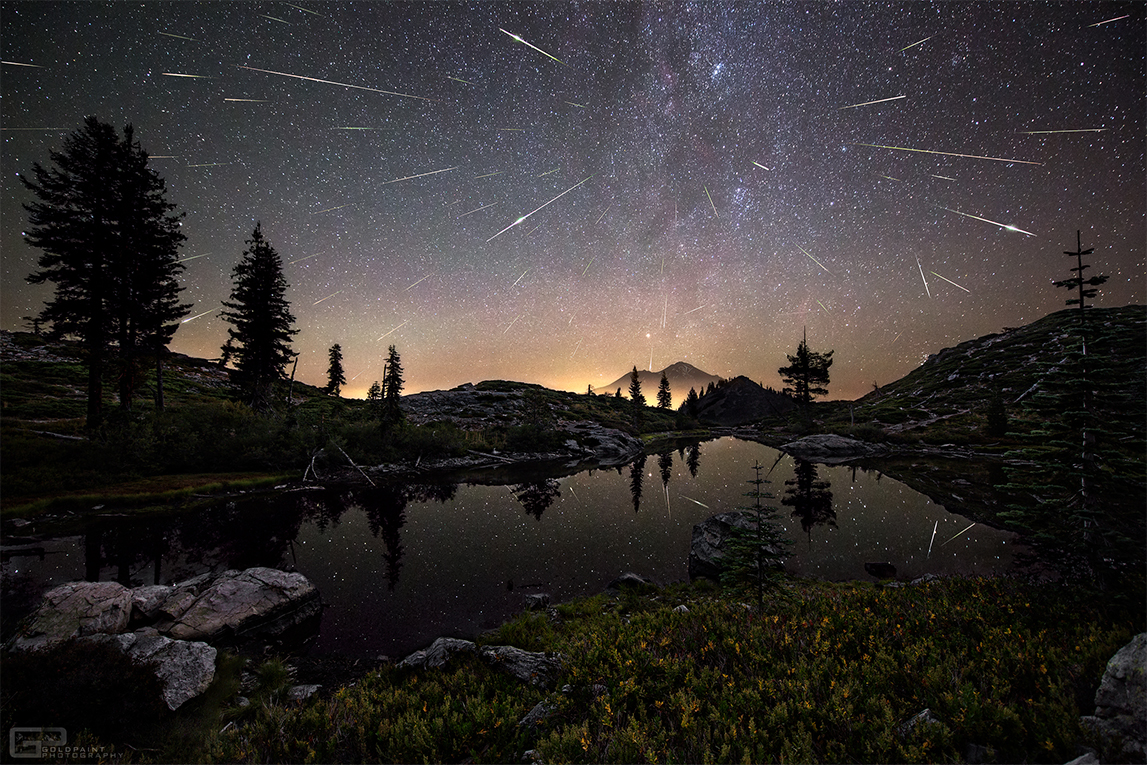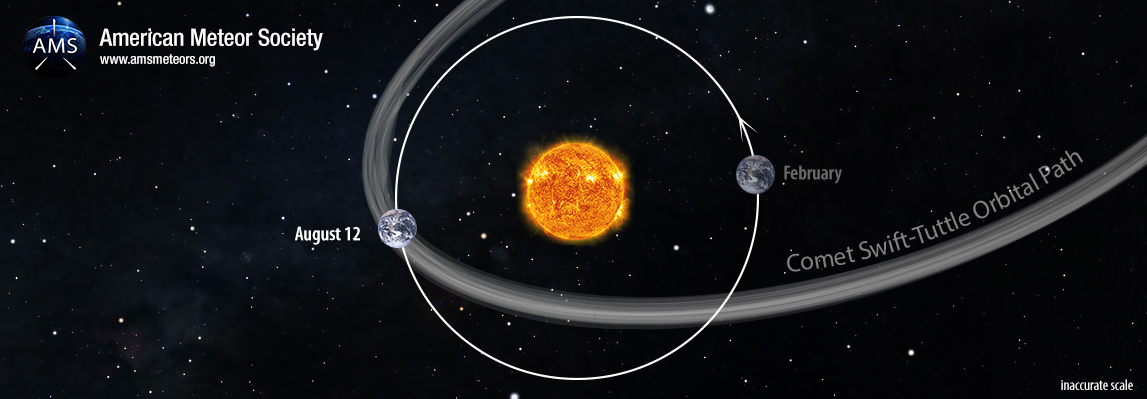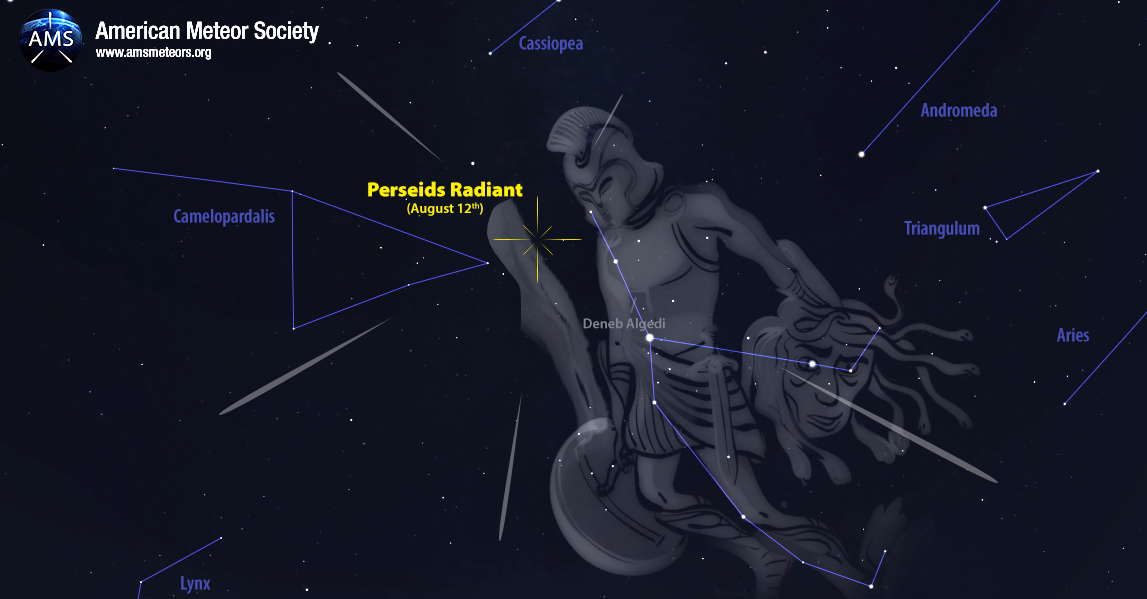
The Perseids are often the most impressive Meteor Shower of the year for the Northern Hemisphere. The Perseids offers a consistently high rate of meteors every year and it occurs in August when the temperatures are usually nice enough for a night under the stars!
Comet Dust
Most people have heard of the Perseid meteor shower, known for producing celestial fireworks every summer in the northern hemisphere. What they don’t often know is what causes this display and what causes it to produce varying levels of activity year to year. We see Perseid meteors when the Earth intersects the orbits of comet 109P/Swift-Tuttle. I mention “orbits” because the comet does not take exactly the same path each time it passes through the inner solar system. When the Earth happens to pass through the center of one of these paths we witness enhanced activity from the Perseids. Most of the time it passes between these paths. The meteors we seen in our skies are actually tiny particles of ice and dust that are released by the comet each time it passes near the sun. They strike the earth’s atmosphere at high velocity of 37 miles per second. At that speed all Perseid meteors disintegrate while still high in the upper atmosphere. Larger Perseid particles produce fireball class meteors and persistent trains that remain in the sky a few seconds after the meteor has disappeared.
Peak: August 12th
The Earth begins to enter the outer edges of the paths of comet 109P/Swift-Tuttle around July 17 and leaves it around September 1st. We are closest to the core around August 12. This is when you will see the most activity. The number of particles in orbit are much greater than for most streams therefore we see more activity from this shower than most others. The closer you view to August 12, the more Perseid activity one will see. There is one other factor that comes into play year to year and that would be the moon. A great majority of the particles the Earth encounters are very tiny and produce meteors so faint that they are invisible to the naked eye. Of course there are Perseid meteors bright enough to be seen but most of these are also faint.

If you try and view the Perseids with a bright moon in the sky the moonlight will obscure these fainter meteors. Unfortunately this is the case this year with a full moon occurring on August 7th. By the time the 12th arrives the moon will have waned to approximately 80% illuminated. This is not much better than a full moon and will certainly pose a challenge in viewing the Perseids this year. To alleviate this problem one could try to view the display before the moon rises, which would be approximately 10pm local daylight saving time on the evening of the 11th. Unfortunately at that time the Perseid radiant, the area of the sky that Perseid meteors appear to shoot from, is located low in the northern sky and the number of meteors seen is the lowest. However, these meteors tend to be very long and long-lasting so it is definitely worth trying to see some of them. Once the moon has risen, it would be advisable to face away from it so that you save your night vision and face the darker portions of the sky where more activity can be seen. Perseid meteors can be seen in all parts of the sky. If you focus on one part of the sky then Perseid meteors will all have similar paths and velocities, only the brightness will be different. This gradually changes throughout the night, depending on the position of the radiant in Perseus.
Radiant
Meteor Showers are named for the constellation out of which they seem to come. Because all of the particles are moving in roughly the same direction, the meteors which strike our atmosphere all “point” back to the direction of the comet’s path. This point in the sky is called the Meteor Shower Radiant. The Perseids appear to come from a point next to the constellation of Perseus. Perseids can be seen anywhere in the sky, but the direction of motion, when traced back, will point to a point next to the Perseus constellation.

The best time to see Perseid activity is when the radiant lies highest above the horizon in a dark sky. For most potential observers this occurs near 4am local daylight saving time. At this time you should be able to see 20-30 Perseids per hour, depending on the transparency of your sky. These rates are better than most of the major annual showers so it is definitely worth trying to view the display this year despite the moonlight. There will also be other meteors visible besides the Perseids. These meteors will be far less numerous and will possess varying velocities and paths through the sky. If you are clouded out on the evening of August 11 or the morning of the 12th, meteor activity will still be good the following night and for a few nights after. The good news for Perseid observers is that the 2018 display will occur near a new moon, when the moon is located near the sun and not visible at night.
We encourage observers to not only view this display but to make scientifically useful hourly counts of the meteors you see. Helpful hints on how to do this are available here. If you are experienced, don’t hesitate to .
Photograph meteors
The Perseids also offer a good opportunity to photograph meteors. To accomplish this you need a camera capable of taking exposures of at least 60 seconds. It also advantageous to have a wide field lens such as a 24mm or 28mm. These lenses are normally “slow” with a focal ratio of 3.5 or higher. These lenses are still capable of capturing meteors but the lower the focal ration the better as “faster” lenses are more capable of capturing these fast streaks of light. If you simply aim your camera at the sky your time exposure will show the stars trailing through the frame. Meteors will appear as straight streaks of light crossing these star trails. Advanced astrophotographers use motorized mounts for their cameras to follow the stars and to avoid star trails. Meteor streaks will appear as they do in the sky, as streaks of light against a starry background.
Clear Skies!
 American Meteor Society
American Meteor Society
I saw a huge meteor in the western sky at 12:32 a.m. CST in Iowa. It had a huge golden head and followed a northward path low in the sky like the Russian sighting video clips I saw on the internet and TV. It was astounding in its size and duration.
Hi, thank for your webpage! This year i can’t find online in which orbit of the 109P we are passing in? Can you help me? Which is the year when this meteoroids were left?
best wishes,
Andrea
Andrea and All,
We are not passing close to any of the past paths of comet 109P therefore we can only expect an ordinary display of Perseid meteors. Factor in the light from the moon and it will be a muted display producing only 20-30 meteors per hour at best.
I hope this helps!
Robert Lunsford
So, what is the best time to view in north America, 11th night or 12th night ?
K and All,
The night of the 11th and morning of the 12th will be the best. If cloudy try Saturday evening/Sunday morning.
Robert Lunsford
Will it be visible from Florida?
Jennifer and All,
The Perseids can be seen anywhere in the northern hemisphere except the polar regions where daylight is 24 hours.
Robert Lunsford
What a great read! Thank you!
I have been teaching myself the art of photography, but have not come into the understanding of taking photos like these. As to not miss this great photo opportunity, I would like to ask a couple questions about camera operations. (Please pardon this night time newbie.)
I have a few lenses. Would either a 75-300 or an 18-55 lens work for something like this? If so, what settings on my camera would be optimal? I would imagine a remote to capture would be best, as I would have my camera on a tripod.
I apologize for the questions. I have just not been able to figure out the night sky yet, but would really love to photograph this event.
Thanks for your time.
Sarah and All,
Use your 18-55mm lens and set it to 18mm to take advantage of the wide field of view. Use the “manual” settings and use the highest ISO value available and limit exposures to no more than 60 seconds. Set the aperture to the lowest “f” stop such as 2.8. Aim your camera in the opposite direction of the moon just high enough to clear the horizon.
I hope this helps!
Robert Lunsford
Which compass direction do I look to? Not everyone knows where the stars are at! ty
Norm and All,
Use the moon as your compass. Put your back to the moon and view in that direction. If you view in the evening before moonrise, view toward your darkest direction as the Perseid meteors can be seen in any part of the sky.
Robert Lunsford
Thank you! Great info!
Hi Robert,
I’m planning on watching and photographing the 2018 Perseids. I’m mostly going to have views to the west from where I want to shoot. Will I be likely to see the same number of meteors in any direction of the sky (assuming light pollution and other factors are equal)? Or, should i find a spot with a clear view to the northeast? Thanks.
Hi Kevin and All,
The numbers should be pretty much the same no matter which direction you choose. It would be best to center your camera half-way up in the sky.
Good Luck!
“When going out to watch the shower, remember to stay away from urban light pollution in order to find complete darkness.”
So that’s most places out then.
I am pleased to say that I watch the Perseides every year.
Last night I did not see the 30 per hour particles of ice. I saw three glowing red meteors. I am so pleased to know that none of them became meteroids.
What say you sky watchers?
Doug
In Islamorada Florida we saw white flash meteors and it was amazing. Thanks for the information.